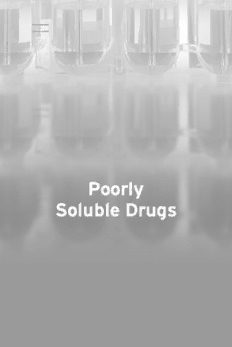
Poorly soluble drugs: dissolution and drug release PDF
Preview Poorly soluble drugs: dissolution and drug release
Poorly Soluble Drugs Pan Stanford Series on Pharmaceutical Analysis Gregory K. Webster Chief Editor J. Derek Jackson and Robert G. Bell Editors Titles in the Series Published Vol. 1 Poorly Soluble Drugs: Solution and Drug Release Gregory K. Webster, J. Derek Jackson, and Robert G. Bell, eds. 2017 978-981-4745-45-1 (Hardcover) 978-981-4745-46-8 (eBook) Forthcoming Vol. 2 Chromatographic Method Development Gregory K. Webster and Laila Kott, eds. 2018 Pan Stanford Series on Renewable Energy — Volume 2 Pan Stanford Series on Pharmaceutical Analysis Volume 1 Poorly Soluble Drugs Dissolution and Drug Release editors Preben Maegaard Anna Krenz edited by Wolfgang Palz Gregory K. Webster J. Derek Jackson Robert G. Bell The Rise of Modern Wind Energy Wind Power for the World November19,2016 14:17 PSPBook-9inx6in 00-Webster-Prelims Publishedby PanStanfordPublishingPte.Ltd. PenthouseLevel,SuntecTower3 8TemasekBoulevard Singapore038988 Email:[email protected] Web:www.panstanford.com BritishLibraryCataloguing-in-PublicationData AcataloguerecordforthisbookisavailablefromtheBritishLibrary. PoorlySolubleDrugs:DissolutionandDrugRelease Copyright(cid:2)c 2017PanStanfordPublishingPte.Ltd. Allrightsreserved.Thisbook,orpartsthereof,maynotbereproducedinany form or by any means, electronic or mechanical, including photocopying, recordingoranyinformationstorageandretrievalsystemnowknownorto beinvented,withoutwrittenpermissionfromthepublisher. For photocopying of material in this volume, please pay a copying fee through the Copyright Clearance Center, Inc., 222 Rosewood Drive, Danvers, MA 01923, USA. In this case permission to photocopy is not requiredfromthepublisher. ISBN978-981-4745-45-1(Hardcover) ISBN978-981-4745-46-8(eBook) PrintedintheUSA November19,2016 14:17 PSPBook-9inx6in 00-Webster-Prelims Contents Foreword xxi 1 TheModernPharmaceuticalDevelopmentChallenge: BCSClassIIandIVDrugs 1 GregoryK.Webster,RobertG.Bell,andJ.DerekJackson 1.1 Introduction 1 1.2 ChangingDrugEmphasis 2 1.2.1 BCSClassificationSystem 3 1.2.2 PoorlySolubleDrugs 4 1.3 TheDissolutionMarket 5 1.4 DissolutionandDrugReleaseinthePharmaceutical Industry 6 1.4.1 SolubilityDeterminationsforPharmaceutical API 7 1.4.2 UseofSurfactantsinDissolutionTesting 7 1.4.3 IntrinsicDissolutionEvaluationofPoorly SolubleDrugs 7 1.4.4 StrategiesforOralDeliveryofPoorlySoluble Drugs 8 1.4.5 AStagedApproachtoPharmaceutical DissolutionTesting 9 1.4.6 DevelopmentandApplicationofinvitro Two-PhaseDissolutionMethodforPoorly Water-SolubleDrugs 9 1.4.7 UseofApparatus3inDissolutionTestingof PoorlySolubleDrugFormulations 10 1.4.8 UseofApparatus4inDissolutionTestingof PoorlySolubleDrugFormulations 10 November19,2016 14:17 PSPBook-9inx6in 00-Webster-Prelims vi Contents 1.4.9 DissolutionofNanoparticleDrug Formulations 11 1.4.10DissolutionofLipid-BasedDrugFormulations 12 1.4.11DissolutionofStabilizedAmorphousDrug Formulations 12 1.4.12DissolutionofPharmaceuticalSuspensions 13 1.4.13BiorelevantDissolution 13 1.4.14ClinicallyRelevantDissolutionfor Low-SolubilityImmediate-Release Products 14 1.4.15MethodValidationandQbDforDissolution TestingofBCSClassII/IVProducts 15 1.4.16RegulatoryConsiderationsinDrugRelease TestingofBCSClassII/IVProducts 15 1.4.17DissolutionofCapsule-BasedFormulations 16 1.4.18EmergingandNon-compendialDrugRelease Techniques 17 2 SolubilityDeterminationsforPharmaceuticalAPI 19 KofiAsare-AddoandBarbaraR.Conway 2.1 Introduction 19 2.2 DrugSolubilityAssayDevelopment 21 2.2.1 MediaforSolubilityStudies 26 2.2.1.1 Biorelevantmedia 26 2.2.1.2 Organicsolvents(DMSO) 29 2.2.1.3 Detectionmethods 31 2.3 DrugSolubilityDetermination 33 2.3.1 Shake-FlaskMethod 33 2.3.2 MiniaturizedShake-FlaskMethod 38 2.3.2.1 Samplepreparationandanalysis 38 2.3.3 PotentiometricTitrationMethods 42 2.3.4 High-throughputSolubilityDeterminations 47 2.4 InsilicoPredictions 55 2.5 OtherPhysicochemicalDeterminations 58 2.5.1 pK 58 a 2.5.2 Lipophilicity 60 2.6 Summary 61 November19,2016 14:17 PSPBook-9inx6in 00-Webster-Prelims Contents vii 3 UseofSurfactantsinDissolutionTesting 85 AmitGupta 3.1 Introduction 85 3.2 Surfactants 86 3.2.1 UseofSurfactantsinDissolutionMedia Development 87 3.2.2 TypesofSurfactantsinDissolution Development 88 3.2.3 SurfactantConcentrationinDissolution Media 88 3.2.4 OtherNon-surfactantMediaAdjuvants 89 3.3 ImpactofSurfactantsonDissolvedGases 90 3.4 CaseStudies 93 3.4.1 Roflumilast 94 3.4.2 Fingolimod 95 3.4.3 Lamotrigine 96 3.4.4 Tacrolimus 98 3.4.5 Amiodarone 99 3.4.6 EnzymeAddition 100 3.5 RegulatoryConcerns 101 4 IntrinsicDissolutionEvaluationofPoorlySolubleDrugs 105 MicheleGeorgesIssaandHumbertoGomesFerraz 4.1 Introduction 105 4.2 ApparatusesUsedinEvaluatingtheIntrinsic DissolutionRate 107 4.2.1 RotatingDiskSystem 107 4.2.2 FixedDiskSystem 107 4.2.3 FlowCell:DissolutionbyUVImaging 109 4.3 CalculatingtheIntrinsicDissolutionRate(IDR) 110 4.4 EvaluationofIntrinsicDissolutionofPoorlySoluble Drugs 112 4.5 DevelopmentofanIntrinsicDissolutionTest 114 4.5.1 TestVariables 114 4.5.1.1 Sample 114 4.5.1.2 Compactionpressure 116 4.5.1.3 Dissolutionmedium 117 November19,2016 14:17 PSPBook-9inx6in 00-Webster-Prelims viii Contents 4.5.1.4 Stirringspeed 117 4.5.2 DesignofExperiments(DOE) 117 4.6 Conclusion 118 5 OralDeliveryofPoorlySolubleDrugs 125 DevPrasad,AkashJain,andSudhakarGarad 5.1 Introduction 126 5.2 OralDelivery 127 5.2.1 PhysicochemicalProperties 128 5.2.1.1 Ionization 128 5.2.1.2 Aqueoussolubility 129 5.2.1.3 Lipophilicity,permeability,and absorption 131 5.2.1.4 Metabolismconsideration 133 5.2.2 Solid-StateProperties 134 5.2.2.1 Morphology 135 5.2.2.2 Hygroscopicity 136 5.2.2.3 Particlesize,shape,andsurface area 137 5.2.3 BiopharmaceuticsandDevelopability Assessment 138 5.3 EnablingFormulationApproachesforPoorly SolubleDrugs 140 5.3.1 ConventionalApproaches 140 5.3.1.1 pHadjustmentandbuffers 140 5.3.1.2 Co-solventsandsurfactants 142 5.3.1.3 Cyclodextrins 144 5.3.2 SaltsandCo-crystals 147 5.3.2.1 Salts 147 5.3.2.2 Co-crystals 151 5.3.2.3 Identifyingtherightsaltor co-crystal 152 5.3.3 ParticleSizeReduction 153 5.3.4 AmorphousFormandSolidDispersion 155 5.3.5 Lipid-BasedFormulations 161 5.3.5.1 Oil/lipidsolutions 161 5.3.5.2 Emulsions 161 5.3.5.3 Self-emulsifyingsystems 163 November19,2016 14:17 PSPBook-9inx6in 00-Webster-Prelims Contents ix 5.3.6 Controlled-ReleaseFormulations 168 5.4 Summary/ConcludingRemarks 170 6 AStagedApproachtoPharmaceuticalDissolutionTesting 187 GregoryK.Webster,XiShao,andPaulD.Curry,Jr. 6.1 Introduction 187 6.2 DissolutionatEachStageofDrugDevelopment 189 6.2.1 PilotFormulationDevelopment 189 6.2.1.1 CMCprojectteam 191 6.2.1.2 Formulationlead 191 6.2.1.3 Dissolutionlead 191 6.2.1.4 PKgroup 192 6.2.1.5 Samplesneeded 192 6.2.2 DevelopmentFormulations:Phase1B/2A 192 6.2.2.1 Projectteam 194 6.2.2.2 Formulationlead 194 6.2.2.3 Dissolutionlead 194 6.2.2.4 PKgroup 196 6.2.2.5 Samplesneeded 196 6.2.3 DevelopmentFormulations:Phase2B 196 6.2.3.1 Projectteam 196 6.2.3.2 Formulationlead 198 6.2.3.3 Dissolutionlead 198 6.2.3.4 PKgroup 199 6.2.3.5 Samplesneeded 199 6.2.4 FinalFormulationDevelopment:Phase3 199 6.2.4.1 Projectteam 200 6.2.4.2 Formulationlead 200 6.2.4.3 Dissolutionlead 201 6.2.4.4 PKgroup 201 6.2.4.5 Samplesneeded 203 6.2.5 Invitro/invivoCorrelation 203 6.2.5.1 Projectteam 204 6.2.5.2 Formulationlead 204 6.2.5.3 Dissolutionlead 204 6.2.5.4 PKgroup 204 6.2.5.5 Samplesneeded 206 6.3 Conclusion 206 November19,2016 14:17 PSPBook-9inx6in 00-Webster-Prelims x Contents 7 DevelopmentandApplicationofinvitroTwo-Phase DissolutionMethodforPoorlyWater-SolubleDrugs 209 PingGao,YiShi,andJonathanM.Miller 7.1 Introduction 209 7.2 DevelopmentandApplicationsofTwo-Phase DissolutionTest 211 7.2.1 OverviewofTwo-PhaseDissolution-Partition Method 211 7.2.2 Experimental 214 7.2.2.1 Apparatus 214 7.2.2.2 Selectionofaqueousmedia 215 7.2.2.3 Selectionoforganicphase 216 7.2.3 CaseStudieswithEmphasisonIVIVR 216 7.2.4 CaseStudiesAssessingSupersaturationand IVIVR 218 7.2.4.1 Felodipine 219 7.2.4.2 Celecoxib 220 7.2.4.3 BIXX 223 7.3 TheoreticalModelingofDrugDissolutionand TransferbetweenTwoPhases 226 7.3.1 GrassiModel 227 7.3.2 AmidonModel 228 7.4 Conclusions 230 8 TheUseofApparatus3inDissolutionTestingofPoorly SolubleDrugFormulations 235 G.BryanCrist 8.1 BackgroundoftheReciprocatingCylinderApparatus 235 8.2 OperationalOverview 238 8.3 TypicalApplicationsforPoorlySolubleCompounds 242 8.3.1 ModificationstotheReciprocatingCylinder 248 8.4 ReciprocatingCylinderApparatusQualification 249 8.5 Summary 252 9 UseofApparatus4inDissolutionTesting,Including SparinglyandPoorlySolubleDrugs 255 RajanJog,GeoffreyN.Grove,andDianeJ.Burgess 9.1 Introduction 255
